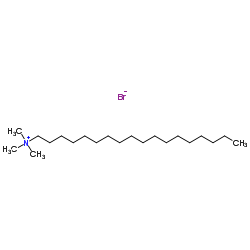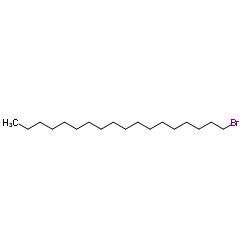Octadecyltrimethylammonium bromide

Octadecyltrimethylammonium bromide structure
|
Common Name | Octadecyltrimethylammonium bromide | ||
|---|---|---|---|---|
| CAS Number | 1120-02-1 | Molecular Weight | 392.501 | |
| Density | N/A | Boiling Point | N/A | |
| Molecular Formula | C21H46BrN | Melting Point | ~250 °C (dec.)(lit.) | |
| MSDS | Chinese USA | Flash Point | N/A | |
| Symbol |

GHS07 |
Signal Word | Warning | |
Use of Octadecyltrimethylammonium bromideTrimethyloctadecylammonium bromide is an inhibitor of dynamin, with an IC50 value of 1.9 μM for dynamin I. Trimethyloctadecylammonium bromide exhibits antibacterial activity against Staphylococcus aureus[1][2]. |
| Name | Stearyltrimethylammonium Bromide |
|---|---|
| Synonym | More Synonyms |
| Description | Trimethyloctadecylammonium bromide is an inhibitor of dynamin, with an IC50 value of 1.9 μM for dynamin I. Trimethyloctadecylammonium bromide exhibits antibacterial activity against Staphylococcus aureus[1][2]. |
|---|---|
| Related Catalog | |
| Target |
IC50: 1.9 μM (Dynamin I)[1] |
| In Vitro | Trimethyloctadecylammonium bromide (1 μM-100 μM; 10 min) inhibits EGF-A488 endocytosis in COS-7 cells, with an IC50 value of 16 μM[1]. Trimethyloctadecylammonium bromide (30 μM; 10 min; 37 ℃) shows no effect on EGFR activation in A431 cells with insignificant EGFR autophosphorylation change[1]. Trimethyloctadecylammonium bromide (stearyl-) (1 nM-1 mM) inhibits Staphylococcus aureus with of 59.5 nM (CKD assay) and 0.33 mM (CMC assay), respectively[2]. |
| Melting Point | ~250 °C (dec.)(lit.) |
|---|---|
| Molecular Formula | C21H46BrN |
| Molecular Weight | 392.501 |
| Exact Mass | 391.281342 |
| LogP | 3.95810 |
| InChIKey | SZEMGTQCPRNXEG-UHFFFAOYSA-M |
| SMILES | CCCCCCCCCCCCCCCCCC[N+](C)(C)C.[Br-] |
| Stability | Stable. Hygroscopic. Incompatible with strong oxidizing agents. Protect from moisture. |
| Water Solubility | soluble |
| Symbol |

GHS07 |
|---|---|
| Signal Word | Warning |
| Hazard Statements | H315-H319-H335 |
| Precautionary Statements | P261-P305 + P351 + P338 |
| Personal Protective Equipment | dust mask type N95 (US);Eyeshields;Gloves |
| Hazard Codes | Xi:Irritant |
| Risk Phrases | R36/37/38 |
| Safety Phrases | S26-S36 |
| RIDADR | NONH for all modes of transport |
| WGK Germany | 3 |
| HS Code | 2923900090 |
|
~% 
Octadecyltrimet... CAS#:1120-02-1 |
| Literature: Journal of the American Chemical Society, , vol. 99, p. 4947 - 4954 Journal of Physical Chemistry, , vol. 88, # 21 p. 5093 - 5099 |
| Precursor 2 | |
|---|---|
| DownStream 1 | |
| HS Code | 2923900090 |
|---|---|
| Summary | 2923900090 other quaternary ammonium salts and hydroxides。Supervision conditions:None。VAT:17.0%。Tax rebate rate:9.0%。MFN tariff:6.5%。General tariff:30.0% |
|
Regular self-motion of a liquid droplet powered by the chemical marangoni effect.
Colloids Surf. B Biointerfaces 56(1-2) , 197-200, (2007) We describe here our recent work on spontaneous regular motion of liquid droplet powered by the chemical Marangoni effect under spatially symmetric conditions. It is shown that a spontaneously crawlin... |
|
|
Spontaneous deformation of an oil droplet induced by the cooperative transport of cationic and anionic surfactants through the interface.
J. Phys. Chem. B 113(48) , 15709-14, (2009) Spontaneous deformation of a tetradecane droplet with palmitic acid on an aqueous phase with stearyltrimethylammonium chloride is reported. Palmitic acid is transported from the oil droplet to the aqu... |
|
|
Removal of non-ionic organic pollutants from water via liquid-liquid extraction.
Water Res. 39(9) , 1907-1913, (2005) The removal of model pollutants bromocresol green (BG) and phenol from water is demonstrated via two liquid-liquid extraction methods. Both methods exploit selective interactions established by the po... |
| Octadecy trimethyl ammonium bromide |
| trimethyl(octadecyl)azanium,bromide |
| EINECS 214-294-5 |
| Trimethyloctadecylammonium bromide |
| Octadecyltrimethylammonium bromide |
| 1-Octadecanaminium, N,N,N-trimethyl-, bromide |
| 1-Octadecanaminium, N,N,N-trimethyl-, bromide (1:1) |
| N,N,N-Trimethyloctadecan-1-aminium bromide |
| N,N,N-Trimethyl-1-octadecanaminium bromide |
| MFCD00043171 |
| Trimethylstearylammonium Bromide |


 CAS#:36087-10-2
CAS#:36087-10-2
